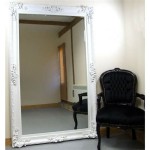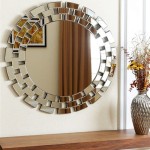Antique Hand Held Mirrors: A Reflection of History and Craftsmanship
Antique hand-held mirrors, more than simple tools for personal grooming, are tangible links to bygone eras. They offer a glimpse into the aesthetic sensibilities, social practices, and technological advancements of the periods in which they were created. These artifacts, often adorned with intricate designs and crafted from precious materials, represent a fascinating intersection of artistry, functionality, and history. Examining antique hand-held mirrors requires an understanding of their construction, historical context, and the factors that influence their value and collectibility.
The evolution of the hand-held mirror parallels the development of glassmaking and decorative arts. Early mirrors, dating back to ancient civilizations, were typically made of polished metal, such as bronze, copper, or silver. These surfaces, though capable of reflecting light, produced imperfect images and required frequent polishing to maintain their reflective quality. The invention of glass mirrors, backed with a reflective metallic coating, marked a significant advancement. This innovation allowed for clearer and more durable reflections, paving the way for more elaborate and decorative designs. The mass production of mirrors during the Industrial Revolution made them more accessible, but the earlier, handcrafted examples remain highly sought after by collectors.
The Anatomy of an Antique Hand-Held Mirror
Understanding the components of an antique hand-held mirror is crucial for authentication and appreciation. The primary elements include the mirror glass, the backing material, the frame or handle, and any decorative embellishments. The mirror glass itself can provide clues about its age and origin. Early glass often exhibits imperfections, such as bubbles or distortions, due to less refined manufacturing processes. The reflective backing, typically made of silver or mercury amalgam, can also indicate the age and quality of the mirror. Silver backings tend to tarnish over time, while mercury amalgam backings, though offering a brighter reflection, are more susceptible to damage. It's important to note that mercury amalgam mirrors can pose a health hazard if the backing is damaged or disturbed.
The frame or handle of the mirror is often the most elaborately decorated element. These components were crafted from a variety of materials, including wood, metal, ivory, bone, and tortoiseshell. The style and ornamentation of the frame can provide valuable information about the period in which the mirror was made. For example, mirrors from the Georgian era (1714-1830) often feature neoclassical motifs, such as garlands, urns, and swags. Victorian mirrors (1837-1901) tend to be more ornate, with elaborate floral designs and intricate carvings. Art Nouveau mirrors (1890-1910) are characterized by flowing lines, organic forms, and the use of materials such as enamel and semi-precious stones. The presence of monograms, crests, or other personalized details can further enhance the historical significance and value of the mirror.
The method of attaching the mirror glass to the frame is another important aspect to consider. Early mirrors were often secured with glue, tacks, or a combination of both. Later examples may have used more sophisticated methods, such as metal clips or screws. Examining the attachment method can help determine the authenticity and originality of the mirror. Repairs and restorations are common in antique mirrors, and it is important to assess the quality and extent of any such work. Original hardware and fittings are highly desirable, as they contribute to the overall integrity and value of the piece.
Historical Context and Cultural Significance
Antique hand-held mirrors offer valuable insights into the social and cultural practices of the past. They reflect evolving attitudes towards beauty, hygiene, and personal presentation. In earlier periods, mirrors were often symbols of wealth and status, owned primarily by the aristocracy and upper classes. The ability to afford a well-made mirror, particularly one with a precious metal frame, indicated a level of economic prosperity and social standing. Mirrors were also frequently included in dowries and presented as gifts, further solidifying their role as valuable and cherished possessions.
The design and decoration of antique hand-held mirrors often reflect the dominant artistic styles and cultural trends of the time. Rococo mirrors, for example, are characterized by their ornate and asymmetrical designs, reflecting the lavishness and extravagance of the 18th-century French court. Art Deco mirrors, on the other hand, exhibit a more streamlined and geometric aesthetic, reflecting the modernism and industrialization of the early 20th century. The materials used in the construction of the mirror, such as ivory, tortoiseshell, or precious metals, also reflect the availability and popularity of these materials during different periods.
Beyond their aesthetic appeal, antique hand-held mirrors can also provide insights into the daily lives of people in the past. Diaries, letters, and other historical documents often mention the use of mirrors for grooming, applying makeup, and creating fashionable hairstyles. These accounts offer a glimpse into the rituals and routines of personal care, revealing how individuals of different social classes presented themselves to the world. Studying these mirrors in conjunction with other historical sources can provide a richer understanding of the social and cultural context in which they were created and used.
Factors Influencing Value and Collectibility
The value and collectibility of antique hand-held mirrors are influenced by a variety of factors, including age, rarity, condition, provenance, and aesthetic appeal. Older mirrors, particularly those from the 17th and 18th centuries, are generally more valuable than later examples, especially if they are in good original condition. Rarity is another important consideration. Mirrors with unique designs, unusual materials, or a documented history are highly sought after by collectors. Mirrors made by renowned makers or associated with important historical figures can command particularly high prices.
Condition plays a critical role in determining the value of an antique hand-held mirror. Mirrors with significant damage, such as cracks, chips, or tarnishing, will typically be worth less than those in excellent condition. Repairs and restorations can also affect the value of the mirror, depending on the quality and extent of the work. While some restoration may be necessary to preserve the mirror, excessive or poorly executed repairs can detract from its authenticity and value. It is essential to carefully assess the condition of the mirror before making a purchase.
Provenance, or the documented history of ownership, can significantly enhance the value of an antique hand-held mirror. Mirrors with a clear and verifiable provenance, particularly those that have been owned by prominent collectors or institutions, are highly desirable. Documentation such as receipts, invoices, and exhibition catalogs can help establish the provenance of the mirror and increase its appeal to collectors. Finally, aesthetic appeal is a subjective but important factor. Mirrors with beautiful designs, intricate carvings, or unusual materials are generally more valuable than those with plain or unremarkable designs. The overall visual impact of the mirror is a significant consideration for many collectors.
In conclusion, antique hand-held mirrors are multifaceted objects that offer a unique perspective on history, craftsmanship, and culture. Their value extends beyond their functional purpose, providing a tangible connection to the past. Understanding their construction, historical context, and the factors that influence their collectibility is essential for both appreciating and preserving these remarkable artifacts.

Vintage Hand Mirror Silver Plated Handheld Ornate Art Nouveau Style Photo Prop Silverplated Parlor Mirrors

Vintage French Inspired Handheld Mirror Apollobox

Hand Mirror Vintage Handheld With Handle Vanity Makeup Travel Mirrors Oval Com

Hand Held Mirror Antique Victorian Ornate Gold

Vintage Hand Mirror And Brush Set Repurposed Art Deco Handheld Mirrors Handmirror Vanityset Mirroandbrush Vintag

Silver Hand Mirror Held Handmade Blue Handheld Israel

Vintage Hand Mirror Stock Photo Adobe

Victorian Hand Mirror With Handle Ornate Handheld

Rich Boxer Vintage Handheld Mirror Embossed Flower Hand Held Makeup Vanity Decorative Cute Broe

Vintage Handheld Mirror Mirrors Shabby Chic Dresser








